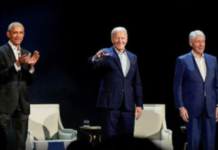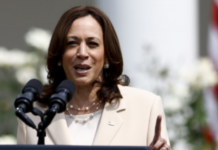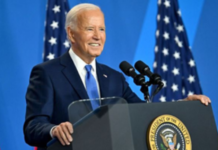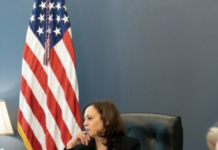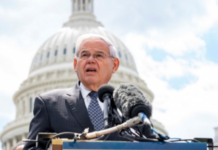
The United States Supreme Court issued rulings this year on some of the most vexing and polarizing issues on the national agenda: church vs. state, abortion, immigration, LGBGT rights, presidential powers. For the first time, citizens and court watchers could compare each ruling with the American public’s attitudes on the issue under scrutiny.
In May, Harvard Kennedy School Professor of Public Policy Maya Sen, Neil Malhotra of Stanford’s Graduate School of Business, and Stephen Jessee of the University of Texas at Austin, published the findings of their new research collaboration called SCOTUSPoll. They surveyed opinions of 2,000 Americans on the issues the court was taking up, and they reported the results as the court’s decisions were unfolding.
When the court ruled last week in the final big decision of this year’s term that President Trump did not have a blanket right to withhold his financial records from prosecutors, the New York Times cited SCOTUSPoll in a front-page graphic putting the decision in the context of public opinion. The researchers also have drawn coverage from the Washington Post, FiveThirtyEight, and other publications.
Maya Sen is a political scientist who writes on issues involving the political economy of U.S. race relations, law and politics, and statistical methods. Her latest book, Deep Roots: How Slavery Still Shapes Southern Politics, won the 2019 William H. Riker Prize for best book in political economy. Her next book, on how American courts become politicized, is being published by Cambridge University Press later this year.
Q: What prompted you to undertake this project?
We know a lot about what people think of decisions made by the president and by Congress. In fact, surveys ask about just about everything President Trump does, from his handling of COVID-19 to his latest inflammatory tweet. But we know fairly little about whether people agree with how the Supreme Court is doing its job. What we do know is that people are broadly supportive of the court and believe in its “legitimacy”—that is, that Supreme Court rulings should be respected and followed. But we don’t know that much about whether people actually agree with the case outcomes themselves.
To be frank, it’s surprising that we know so little. The court is co-equal to Congress and the presidency, and it decides cases with high public impact. The topics it addresses range from civil rights to presidential powers to reproductive freedoms. Court opinions reach everything we care about, from how students here at Harvard are admitted to whether and how states like Massachusetts can combat climate change.
Given that, we feel our study, which asks people what they think about issues that the court will rule on, is critical. Is the court in step with public opinion? If not, then how and to what extent does it differ? Will this change in the coming years as newer justices come onto the bench? Our study will enable people to understand these sorts of questions by allowing explicit comparisons between public opinion and the court’s rulings.
Q: Why is it important to know what the public thinks about issues before the U.S. Supreme Court? Shouldn’t the highest court be independent of what the public thinks?
The U.S. Supreme Court is an institution that is fairly insulated from public opinion—and with good reason. The framers of the U.S. Constitution understood that certain things—the protection of minority rights, for example—should never be subject to the whims of public sentiment. So, it was very important for the framers to establish an independent judiciary, headed in our system of government by the Supreme Court.
Even so, understanding whether and how the Supreme Court reflects public thinking is important. We know where our current president and our elected representatives fall on these issues. So, shouldn’t we know the same about the justices?
We hope that our research will provide citizens a simple tool to understand and evaluate how close or removed the justices are from the public on these issues.
We also think that this research could, over time, help inform what candidates and platforms Americans back. Research by other scholars has shown that citizens cast votes for their senators based in part on how those senators vote on U.S. Supreme Court confirmations. The same thing is true of the president. We hope our research will help equip citizens to make better, more informed choices.
Q: Broadly, it seems the court’s rulings were in line with public opinion on most of these issues. Did you expect that, and is that consistent with what we know about the court’s alignment with public views in past years? Is this court the same as its predecessors in that sense?
Our study showed that most Americans supported the liberal side in the key cases before the court this term. This included important cases involving LGBTQ rights, abortion access, DACA (Deferred Action for Childhood Arrivals), and presidential powers (specifically President Trump’s tax returns). In only a few cases—for example, a religious scholarships case—did the majority of people in our study support the conservative side.
So, what did we expect from this court? With Anthony Kennedy’s retirement in 2018 and with the subsequent confirmation of conservative Brett Kavanaugh, the court’s ideological center of gravity—what scholars call the “ideological median”—has shifted to the right. Now, instead of a more center-right judge like Anthony Kennedy, we have a solid conservative—Chief Justice John Roberts—holding the court’s powerful central position.
Given that Roberts is now the person most likely to cast a pivotal fifth vote, most court watchers expected the court to shift to the right across key issues. But that did not happen this year. Instead, the court ruled in favor of the liberal position across key cases, including the cases involving LGBTQ rights, abortion access, DACA, and presidential powers.
Like other court watchers, we were surprised. After all, Roberts was the key swing vote on many of these cases, and he’s hardly liberal.
However, our study showed that the court’s position in every major case this term was exactly in line with public opinion. This could provide helpful context for the otherwise surprising rulings. For example, in Bostock v. Clayton County—the court’s LGBTQ-workers’ rights case—our data showed that 83 percent of Americans believed that it should be illegal to terminate a worker because of LGBT status. The number was still high—74 percent–looking only at the Republicans in the study.
In this case, the court ruled 6-3 in favor of LGBTQ rights. This was surprising to scholars, given the court’s ideological make-up. But with the deeper political context showing very overwhelming support for LGBT rights among members of the public, it is perhaps less surprising. We hope to explore this close connection between public sentiment and the court’s rulings in future work.
Q: With the benefit of knowing the outcomes, how do you measure the court’s legitimacy now after all these rulings have been made?
One thing that’s very exciting about doing research in real time is that your hypotheses are proved or disproved as you and the rest of the world are watching. We originally thought that the court would be out of step with public opinion, since our data showed that most people preferred the liberal side in each major case (with only a few exceptions) and we knew that the court was leaning in a conservative direction—especially with the new justices Neil Gorsuch and Brett Kavanaugh.
Much to our surprise, we saw that the court sided with the liberal position in a lot of these really important cases, with Roberts frequently siding with the court’s four liberal justices.
For us, the biggest surprise wasn’t any particular case, but the fact that public opinion was highly predictive of how the court actually ruled. In case and after case, our study predicted the court’s ruling (even though this wasn’t the explicit aim of our work). Our survey even predicted some of the more conservative rulings—for example, the court’s ruling in Espinoza v. Montana Department of Revenue that states cannot prevent state-sponsored scholarships from being used at religious institutions. Our study showed that this was one of the few cases where a majority of Americans—63 percent–supported the conservative position that eventually won out at the Supreme Court.
A big question is why we saw this close relationship between public opinion and the court’s rulings. Will this relationship hold in future years? We hope to conduct this survey every year moving forward, so we will soon know the answer. Is Roberts—who was the swing vote on a lot of these cases—particularly sensitive to the public mood? Possibly. Was the Trump administration’s position on certain cases particularly weak? Also possibly.
Q: How do you intend to use this research project in your teaching? What lessons would you want students to take away from this work?
At HKS, I teach courses on statistics, inequality, and judicial processes, and this research has a home in each of those courses.
This is brand-new research and, to our knowledge, nobody has asked the general public how they feel about the exact issues before the court. So, first, we hope that this research illustrates the importance of doing timely descriptive work. Second, we hope this work invites students to think outside the box in terms of democratic representation and accountability. Just because an institution is purposefully insulated from public opinion doesn’t mean that we shouldn’t examine and question how representative it is. Third, we think that this work is highly relevant to policy and could help us think through potential avenues of policymaking. For example, our research shows that the public is highly supportive of including LGBTQ individuals within the scope of protections against discrimination on the “basis of sex.” This could be a productive venue for policymakers moving forward.
Overall, we hope that we push students toward asking big, important questions, and to not hesitate to move quickly.
(Reprinted with permission from the Harvard Gazette.)





